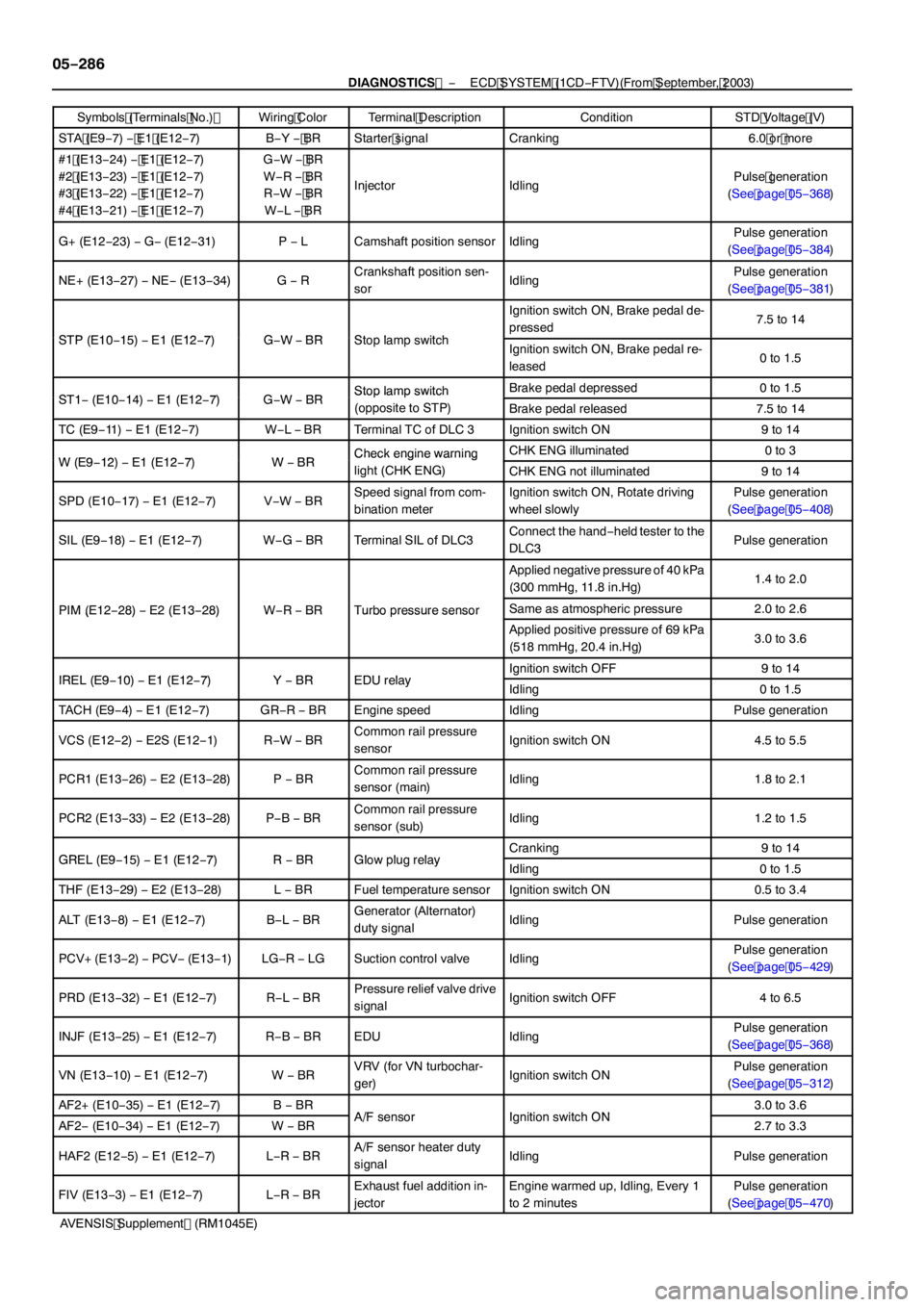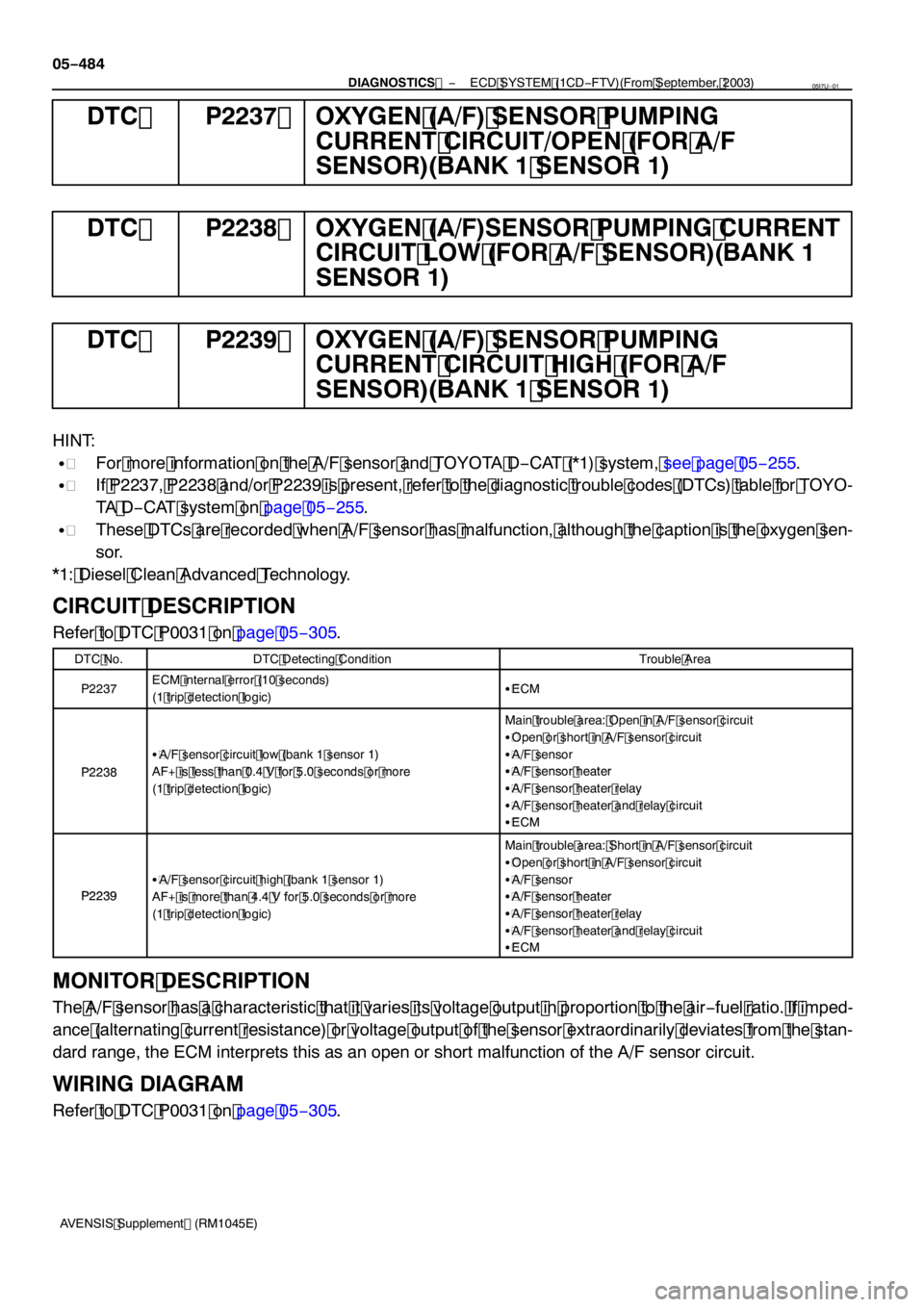2005 TOYOTA AVENSIS wiring
[x] Cancel search: wiringPage 4293 of 5135

A91217
MREL
W
GRE9
IE5
B
Battery FL MAINAF2+ 8
1 126
Engine Room
R/B No. 1ECM
6AGR
3AF2−
HAF2
E1 E1035
E1034 1
IP1 (RHD)(LHD) 1
2
W
1
2
1
11B
W
2
1
325
3
W−B
A
A
A
W−B(RHD)
(LHD)W−B
A
IP IKEI J17
J/C
J15
J/C B−R
Fuse Block
A/F AM1 No. 1 140A ALT
A35
A/F Sensor
Relay B−R
W
(*1)W
(*2)
IH2 1
B−W
(*1)A34A34 A34 A34A34
A34
A34
A34 2
2 11 3
44
3
+B AF+
AF−
HT B
(*1)
(*2)
(*1)
(*2) (*2)
B(*1)
(*3)W(*1)
W
(*2) IH2 3
IH2 4
B
(*1)BR
(*1)
A34
A/F sensor BR
E12
E127 5
IK1 3
L−RL−R
(*2)
L−R
(*1) IH2
2R
(*1)
BR J/C J13
J12 D
E
BR
*1: w/ Headlight Beam Level Control
*2: w/o Headlight Beam Level Control
*3: Shielded
− DIAGNOSTICSECD SYSTEM (1CD−FTV)(From September, 2003)
05−307
AVENSIS Supplement (RM1045E)
WIRING DIAGRAM
Page 4314 of 5135

054KK−10
A66714
E13
E12E10
E9
− DIAGNOSTICSECD SYSTEM (1CD−FTV)(From September, 2003)
05−285
AVENSIS Supplement (RM1045E)
TERMINALS OF ECM
HINT:
Each ECM terminal’s standard voltage is shown in the table below.
In the table, first follow the information under ”Symbols (Terminals No.)”. Look under ”Tester Connection” for
the terminals to be inspected. The standard voltage between the terminals is shown under ”STD Voltage
(V)”.
Use the illustration above as a reference for the ECM terminals.
Symbols (Terminals No.)Wiring ColorTerminal DescriptionConditionSTD Voltage (V)
BATT (E10−2)−E1(E12−7)B−Y−BR
Battery (for measuring the
battery voltage and for the
ECM memory)
Always9to14
IGSW (E9−9)−E1(E12−7)B−W−BRIgnition switchIgnition switch ON9to14
+B (E9−1)−E1(E12−7)B−W−BRPower source of ECMIgnition switch ON9to14
MREL(E98)E1(E127)GRBRECDrelayIgnition switch ON9to14MREL(E9−8)−E1(E12−7)GR−BRECD relayIgnition switch OFF0to1.5
VC (E13−18)−E1(E12−7)R−W−BRPower source of sensor
(a specific voltage)Ignition switch ON4.5 to 5.5
VPA(E922)EPA(E928)GY
Accelerator pedal position
sensor(fortheengine
Ignition switch ON, Accelerator ped-
al fully released0.5 to1.1
VPA(E9−22)−EPA(E9−28)G−Ysensor (for the engine
control)Ignition switch ON, Accelerator ped-
al fully depressed2.6 to 4.5
VPA2(E923)EPA2(E929)WY
Accelerator pedal position
sensor(forthesensor
Ignition switch ON, Accelerator ped-
al fully released1.2 to 2.0
VPA2 (E9−23)−EPA2 (E9−29)W−Ysensor (for the sensor
malfunction detection)Ignition switch ON, Accelerator ped-
al fully depressed3.4 to 5.3
VCPA (E9−26)−EPA (E9−28)B−Y
Power source of acceler-
ator pedal position sensor
(for VPA)
Ignition switch ON4.5 to 5.5
VCP2 (E9−27)−EPA2 (E9−29)B−Y
Power source of acceler-
ator pedal position sensor
(for VPA2)
Ignition switch ON4.5 to 5.5
VG (E12−24)−EVG (E12−32)G−L−YMass air flow meterIdling0.5 to 3.4
THA (E13−31)−E2 (E13−28)G−R−BRIntake air temperature
sensorIdling, Intake air temperature at
20˚C (68˚F)0.5 to 3.4
THIA (E13−20)−E2 (E13−28)GR−BRIntake air temperature
sensorIdling, Intake air temperature at
80˚C(176˚F)0.3 to 0.9
THW (E13−19)−E2 (E13−28)B−W−BREngine coolant tempera-
ture sensorIdling, Engine coolant temperature
at 80˚C(176˚F)0.2 to1.0
Page 4315 of 5135

05−286
−
DIAGNOSTICS ECD SYSTEM (1CD −FTV)(From September, 2003)
AVENSIS Supplement (RM 1045E)
Symbols (Terminals No.)
STD Voltage (V)
Condition
Terminal Description
Wiring Color
STA (E9 −7) − E1 (E 12− 7)B −Y − BRStarter signalCranking6.0 or more
#1 (E 13− 24) − E1 (E 12− 7)
#2 (E 13− 23) − E1 (E 12− 7)
#3 (E 13− 22) − E1 (E 12− 7)
#4 (E 13− 21) − E1 (E 12− 7)G −W − BR
W −R − BR
R −W − BR
W −L − BR
InjectorIdlingPulse generation
(See page 05 −368)
G+ (E 12− 23) −G− (E 12− 31)P −LCamshaft position sensorIdlingPulse generation
(See page 05 −384)
NE+ (E 13− 27) −NE −(E 13− 34)G −RCrankshaft position sen-
sorIdlingPulse generation
(See page 05 −38 1)
STP(E 10 15)E 1(E 12 7)G WBRStopla ps itch
Ignition switch ON, Brake pedal de-
pressed7.5 to 14
STP (E 10−1 5)−E1 (E 12− 7)G −W− BRStop lamp switchIgnition switch ON, Brake pedal re-
leased0to 1.5
ST 1(E10 14)E 1(E 12 7)G WBRStoplampswitchBrake pedal depressed0to 1.5ST 1− (E10−1 4)−E1 (E 12− 7)G −W− BRStoplampswitch
(opposite to STP)Brake pedal released7.5 to 14
TC (E9 −11)− E1 (E 12− 7)W −L −BRTerminal TC of DLC 3Ignition switch ON9to 14
W(E9 12)E 1(E 12 7)WBRCheck engine warningCHK ENG illuminated0to3W (E9 −12)−E1 (E 12− 7)W −BRCheckenginewarning
light (CHK ENG)CHK ENG not illuminated9to 14
SPD (E 10−1 7)−E1 (E 12− 7)V −W −BRSpeed signal from com-
bination meterIgnition switch ON, Rotate driving
wheel slowlyPulse generation
(See page 05 −408)
SIL (E9 −18)−E1 (E 12− 7)W −G −BRTerminal SIL of DLC3Connect the hand −held tester to the
DLC3Pulse generation
Applied negative pressure of 40 kPa
(300 mmHg, 11.8 in.Hg)1.4 to 2.0
PIM (E 12− 28) −E2 (E 13− 28)W −R −BRTurbo pressure sensorSame as atmospheric pressure2.0 to 2.6PIM(E 12 28)E2(E13 28)W RBRTurbopressuresensor
Applied positive pressure of 69 kPa
(518 mmHg, 20.4 in.Hg)3.0 to 3.6
IREL(E9 10)E 1(E 12 7)YBREDUrelayIgnition switch OFF9to 14IREL (E9 −10)−E1 (E 12− 7)Y− BREDU relayIdling0to 1.5
TACH (E9 −4) −E1 (E 12− 7)GR −R −BREngine speedIdlingPulse generation
VCS (E 12− 2) −E2S (E 12−1 )R−W −BRCommon rail pressure
sensorIgnition switch ON4.5 to 5.5
PCR 1(E 13− 26) −E2 (E 13− 28)P −BRCommon rail pressure
sensor (main)Idling1.8 to 2. 1
PCR2 (E 13− 33) −E2 (E 13− 28)P −B −BRCommon rail pressure
sensor (sub)Idling1.2 to 1.5
GREL(E9 15)E 1(E 12 7)RBRGlowplugrelayCranking9to 14GREL(E9 −15)−E1 (E 12− 7)R −BRGlowplug relayIdling0to 1.5
THF (E 13− 29) −E2 (E 13− 28)L −BRFuel temperature sensorIgnition switch ON0.5 to 3.4
ALT (E 13− 8) −E1 (E 12− 7)B −L − BRGenerator (Alternator)
duty signalIdlingPulse generation
PCV+ (E 13− 2) −PCV −(E 13−1 )LG −R −LGSuction control valveIdlingPulse generation
(See page 05 −429)
PRD (E 13− 32) −E1 (E 12− 7)R −L − BRPressure relief valve drive
signalIgnition switch OFF4 to 6.5
INJF (E 13− 25) −E1 (E 12− 7)R −B −BREDUIdlingPulse generation
(See page 05 −368)
VN (E 13−1 0)−E1 (E 12− 7)W −BRVRV (for VN turbochar-
ger)Ignition switch ONPulse generation
(See page 05 −312)
AF2+ (E 10− 35) −E1 (E 12− 7)B −BRA/FsensorIgnitionswitchON3.0 to 3.6
AF2 −(E 10− 34) −E1 (E 12− 7)W −BRA/F sensorIgnition switch ON2.7 to 3.3
HAF2 (E 12− 5) −E1 (E 12− 7)L− R −BRA/F sensor heater duty
signalIdlingPulse generation
FIV (E 13− 3) −E1 (E 12− 7)L− R −BRExhaust fuel addition in-
jectorEngine warmed up, Idling, Every 1
to 2 minutesPulse generation
(See page 05 −470)
Page 4316 of 5135

−
DIAGNOSTICS ECD SYSTEM (1CD −FTV)(From September, 2003)
05 −287
AVENSIS Supplement (RM 1045E)
Symbols (Terminals No.)
STD Voltage (V)
Condition
Terminal Description
Wiring Color
THCO (E 12− 30) −E2 (E 13− 28)B −Y −BRExhaustgas temperatureEnginewarmedupIdling46to49THCI (E 12− 22) −E2 (E 13− 28)B −BR
Exhaustgastemperature
sensorEngine warmed up, Idling4.6 to 4.9
EGRS (E 12− 3) −E2 (E 13− 28)R −L − BREGR valve duty signalEngine warmed up, IdlingPulse generation
(See page 05 −393)
EGLS (E 12− 33) −E2 (E 13− 28)R −BREGR valve position sen-
sorIgnition switch ON0.6 to 1.4
PEX (E 12− 20) −E2 (E 13− 28)W −BRDifferential pressure sen-
sorIgnition switch ON, differential pres-
sure at 0 kPa1.2 to 1.8
VLU(E 12 29)E2(E13 28)LWBRIntake shutter(throttle
Ignition switch ON, Intake shutter
(throttle valve) fully opened3.0 to 4.0
VLU (E 12− 29) −E2 (E 13− 28)L−W− BRIntakeshutter(throttle
valve) position sensorIgnition switch ON, Intake shutter
(throttle valve) fully closed0.4 to 1.0
LUSL (E 12− 4) −E2 (E 13− 28)G −R −BRIntake shutter (throttle
valve) duty signalEngine warmed up, Racing enginePulse generation
(See page 05 −403)
Page 4367 of 5135

A81015
Engine
Room
R/B No. 1W
9ECM
W
E912
1 2
B
B−W22 1
3
Battery4
2 DH 6
B−R B−R
C11
Combination
Meter Assy
Check
Engine
Warning
Light AM2
IG2
AM2
Driver
Side
J/B
FL MAINEngine
Room
R/B
No. 3
3B 1A 1B−R
IE41
(LHD)IP11
(RHD)
18 DA
J8C
(LHD)J26A
(RHD)J8C
(LHD)J26A
(RHD) J/CB−W IGNI13
Ignition
Switch
− DIAGNOSTICSECD SYSTEM (1CD−FTV)(From September, 2003)
05−497
AVENSIS Supplement (RM1045E)
CHECK ENGINE WARNING LIGHT CIRCUIT
CIRCUIT DESCRIPTION
If the ECM detects a trouble, the CHK ENG is illuminated. At this time, the ECM records the DTC in its
memory.
WIRING DIAGRAM
INSPECTION PROCEDURE
HINT:
Troubleshoot each trouble symptom in accordance with the chart below .
Reference:
ResultProceed to
CHK ENG remains onStart inspection from step 1
CHK ENG is not illuminatedStart inspection from step 3
05B62−07
Page 4369 of 5135

A81016
ECM
STA
E97
B−Y
IJW−BJ12
B B
J13
J/C W−B 1 5
32 1AM2 2
B
B−R1
S51
S4
Starter
Battery7IK1
FL MAIN 3 3
Engine Room
R/B No. 3
B B 55
55 1
11A
BB−R
IE41
(LHD)IP11
(RHD)B−R
Engine
Room
R/B No. 1
Driver
Side R/B ST
Relay
2
DJ
9
DADriver
Side J/B B−R
B−RI13
Ignition Switch
4
5
AM2 ST2B−Y
B−Y
6
2ST 1
6 Fuse
Block
B−WB−YB−Y B−Y
J12
A C
J13C
J13 05−494
− DIAGNOSTICSECD SYSTEM (1CD−FTV)(From September, 2003)
AVENSIS Supplement (RM1045E)
STARTER SIGNAL CIRCUIT
CIRCUIT DESCRIPTION
HINT:
While the engine is being cranked, current flows from terminal ST2 of the ignition switch to the ST relay coil
and also current flows to terminal STA of the ECM (STA signal).
WIRING DIAGRAM
05I7V−01
Page 4372 of 5135

A81013
ECM
+BMREL IGSW J27
9
B−W I13
Ignition Switch
6IGNB−W E
E1
EE110BR
W−B 1Driver Side J/B
2 2
1E9
E9
E98
1
7
E12 J26A
B−W
C C B−W
J8
J/C DA 18
DH2
4
EFI5
1
32 EFI
MAIN
Relay
B−W Engine Room R/B No. 1IK1
6J/C
IE12
BR B−R
Battery AM2B−W
EC
EI
AM2 IG2
GR
B B
33
Engine Room R/B No. 3
FL MAIN1 1
1 1A1 1
1 1 B−R B−R
IE4 1(LHD)
IP1 1(RHD)B−W (RHD) (RHD)
(LHD)
(LHD)
GR B−Y (RHD) B−R (LHD)
− DIAGNOSTICSECD SYSTEM (1CD−FTV)(From September, 2003)
05−489
AVENSIS Supplement (RM1045E)
ECM POWER SOURCE CIRCUIT
CIRCUIT DESCRIPTION
When the ignition switch is turned to ON, the positive battery voltage is applied to terminal IGSW of the ECM
and the EFI MAIN relay control circuit in the ECM sends a signal to terminal MREL of the ECM switching
on the EFI MAIN relay.
This signal causes current to flow to the coil, closing the contacts of the EFI MAIN relay and supplying power
to terminal +B of the ECM.
WIRING DIAGRAM
05B5V−05
Page 4377 of 5135

05−484
−
DIAGNOSTICS ECD SYSTEM (1CD −FTV)(From September, 2003)
AVENSIS Supplement (RM 1045E)
DTC P2237 OXYGEN (A/F) SENSOR PUMPING
CURRENT CIRCUIT/OPEN (FOR A/F
SENSOR)(BANK1 SENSOR 1)
DTC P2238 OXYGEN (A/F)SENSOR PUMPING CURRENT CIRCUIT LOW (FOR A/F SENSOR)(BANK 1
SENSOR 1)
DTC P2239 OXYGEN (A/F) SENSOR PUMPING CURRENT CIRCUIT HIGH (FOR A/F
SENSOR)(BANK1 SENSOR 1)
HINT:
S For more information on the A/F sensor and TOYOTA D −CAT (* 1) system, see page 05 −255.
S If P2237, P2238 and/or P2239 is present, refer to the diagnostic trouble codes (DTCs) table for TOYO-
TA D −CAT system on page 05 −255.
S These DTCs are recorded when A/F sensor has malfunction, although the caption is the oxygen sen-
sor.
* 1 : Diesel Clean Advanced Technology.
CIRCUIT DESCRIPTION
Refer to DTC P003 1 on page 05 −305.
DTC No.DTC Detecting ConditionTrouble Area
P2237ECM internal error ( 10 seconds)
( 1 trip detection logic)S ECM
P2238
S A/F sensor circuit low (bank 1 sensor 1)
AF+ is less than 04 V for 50 seconds or more
Main trouble area: Open in A/F sensor circuit
S Open or short in A/F sensor circuit
S A/F sensor
S A/F sensor heaterP2238AF+ is less than 0.4 V for 5.0 seconds or more
( 1 trip detection logic)S A/F sensor heater
S A/F sensor heater relay
S A/F sensor heater and relay circuit
S ECM
P2239
S A/F sensor circuit high (bank 1 sensor 1)
AF+ is more than 44 V for 50 seconds or more
Main trouble area: Short in A/F sensor circuit
S Open or short in A/F sensor circuit
S A/F sensor
S A/F sensor heaterP2239AF+ is more than 4.4 V for 5.0 seconds or more
( 1 trip detection logic)S A/F sensor heater
S A/F sensor heater relay
S A/F sensor heater and relay circuit
S ECM
MONITOR DESCRIPTION
The A/F sensor has a characteristic that it varies its voltage output in proportion to the air −fuel ratio. If imped-
ance (alternating current resistance) or voltage output of the sensor extraordinarily deviates from the stan-
dard range, the ECM interprets this as an open or short malfunction of the A/F sensor circuit.
WIRING DIAGRAM
Refer to DTC P003 1 on page 05 −305.
05I7U −01